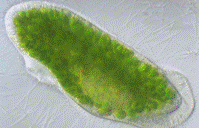Biological Sciences, School of

School of Biological Sciences: Faculty Publications
Document Type
Article
Date of this Version
10-1898
Abstract
During the summer of 1897, at the University of Chicago, I began a morphological investigation of certain species of Alliuin, being attracted chiefly by the often quoted polyeinbryony of A. tricoccum Ait. My results in the case of this species indicate that if polyembryony occurs at all, it is very rare. Besides A. tricoccum, I examined more or less thoroughly A. cernuum Roth, and A. Canadense Kalm, with the same general result. Seventy-five embryo-sacs of A. tricoccum were examined at the stage in which both egg apparatus and antipodal cells ought to have been found. The egg apparatus was found in seventy of them, and the appearance of the sacs in which it was not found would indicate that it had been lost by accident, as all other structures were normal. Of the seventy-five sacs, only sixteen contained antipodal cells, and these antipodal cells were usually small, and it was seldom that more than one or two could be found. In one sac there were three antipodal cells in a row, but in other cases where three were found they were crowded together irregularly. Wherever antipodal cells were found, they had a shriveled, dead appearance, and stained with difficulty or not at all. Twenty-six embryos were examined, all of which had developed from the egg cell. No trace of antipodal cells could be found in any sac in which the embryo had begun to develop.


Comments
Published in Botanical Gazette, Vol. 26, No. 4 (October 1898), pp. 277–278.